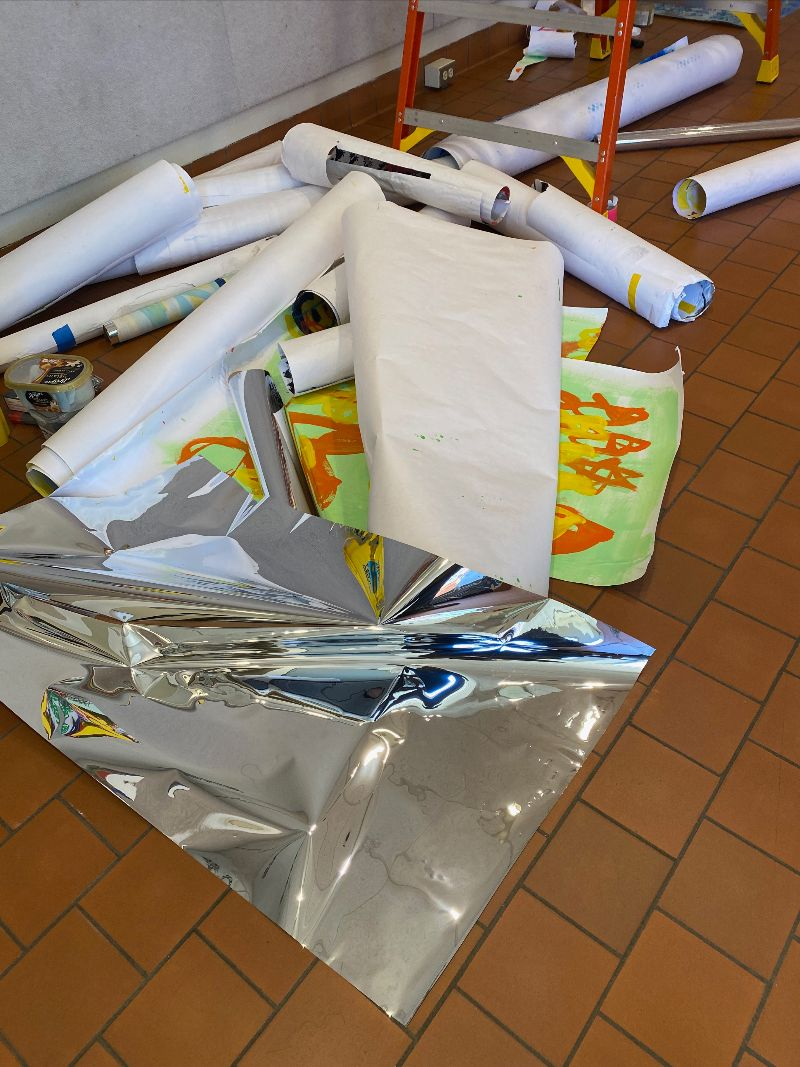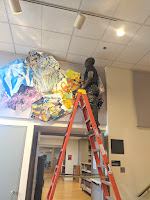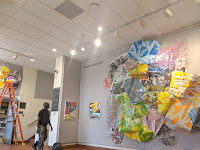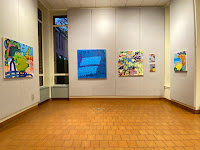Monday, November 28, 2022
CONTENTS/INTRODUCTION/Vegetables
Saturday, November 26, 2022
What I've learned...so far...
- Making unplanned work in public forces action
- Fear creates energy to move ahead with the work
- Having people witness your creative process can be affirming
- Having people witness your creative process feels like electrified nakedness
- Using the drawings in different places and ways always seems to open up new possibilities
- I love manipulating (tearing, folding, creasing...) the drawings from one installation to the next and seeing how they change
- When that weird middle section of the install happens and I want to rush to get past it, I let myself feel the angst, and then take extra long, deep breaths and walk away if need be. Same as when I'm in the studio.
- My palms always get sweaty when it comes to heights, no matter how safe I am
- When people ask questions about what I'm making, it forces me to get better at making good, short answers
- My stomach is in knots the whole time
- Transforming a space through artistic intervention is a great uplifting experience
Thursday, November 24, 2022
Easy isn't bad
The above quote and response comes from my reply to a friend's IG post about making things that are "easy" and still of quality. I've had my battles with the way of thinking that can infect creative people across disciplines. The myth that "all great art is the result of struggle" is just that, a myth. A way of thinking that follows from the idea that life is hard and when you struggle to gain status or other social/financial reward, then that reward carries even more merit somehow. With artists, it's perceived that struggles with mental illness or other neural divergent behavior is somehow responsible for their art rather than that person being able to make their in spite of their mental illnesses, not because of them.
I've not had any issues with mental illness in my life, thankfully, and that has never been a barrier to making good art. I'm not in the position of determining if any of my work is "great" or not, but I can say that not having a mental illness or addiction problem hasn't stopped me from making what I consider some very strong, worthwhile art work. Now, I do struggle with aspects of my work all of the time, but that doesn't equate to the work being better than something that was "easy". All I'm getting at is that artists need to reject the notion that they have to have a bad life or bad experiences to produce good work. It's complete nonsense.
I've struggled with making and/or appreciating work that I considered "easy", where the solution came so easily that I questioned the work's worth. Over time, I've gotten better with this and now find myself embracing a much wider range of thought surrounding what makes my work good or not in my eyes. The easy stuff should be embraced and enjoyed as much as the more difficult work. It's ok to make "easy" work and to enjoy it. There's nothing wrong with liking your easy work. If it brings you joy, why not? Something that you work on for days or months doesn't necessarily mean that it's any better than something that you made in a half-hour. Your worth as an artist isn't tied to how long or how hard something was to bring into existence, your worth as an artist is what you make of it. Nothing else.
ArtSmack
Tuesday, November 22, 2022
(Not Just) Another Day
Recently, I ran into a young artist that I know in the stairwell of our studio building. I asked him how things were going in the studio where he works as an assistant and he replied "not bad". Then I asked, "How are you?" and he replied, "Well, you know, just another day..." I was on my way out to grab a couple of snacks from the nearby supermarket and once I was outside and on my way up the block, I thought about what he'd said, "...just another day..." In the past, that phrase might not have bothered me that much, but for some reason it hit different this time. My thought was, no, this is not "just another day" and it kind of saddened me a bit because we seem to be conditioned to view each day as just like any other in our routines.
Now, the phrase "just another day" is often used as a metaphor for "nothing special is happening, I'm just going about my regular routine", which is often the case. There's a certain amount of surface sameness in a lot of our everyday lives which makes it feel like one day is just bleeding into another without any kind of distinguishing value. On the other hand, "just another day" can also elicit feelings of heaviness and/or sadness, coded language for "this is just another day of drudgery and misery"
I feel like this is symptomatic of how work culture in the U.S. tends to drain as much joy out of our daily lives as possible. There is so much outward sameness with our routines around jobs, going about our daily tasks and other things that repeat hour after hour, day after day that it's hard not to think of each day as the same as the last. All of us here need to figure out how to bring money into our lives just to be able to live day-to-day. That often leads us to be employed in jobs that we don't like, that I think most of us would quit if it weren't for whatever our needs are.
What I believe I heard in the young artist's "Just another day" was this: "It's just another day of giving my energy to someone else's pursuits, dreams and goals". I know that's how I felt during the years where I worked in retail jobs while also making art and having shows. No matter how much I liked where I was working, and I had a couple of favorite workplaces, there was always that feeling of frustration in the back of my mind about giving over so much of my energy to a job that advanced someone else's goals and not my own. In 2020, I got to walk away from my last regular job to pursue my life as a "full time" painter. I put full time in quotes because no matter where I worked in the past, I always prioritized my art life over the steady job. When you're an artist of any discipline, you're never divorced from what you're creating because it's always on your mind. When I was at work, I'd be going over ideas and possibilities in my head about what I wanted to do the next time I was in the studio.
Even though those days weren't strictly the same, the overall feeling was that they were because of the baked-in repetition of tasks. Some days, I'd feel more annoyed than others that I had to be at the job when I sorely wanted to be in the studio working out whatever my latest ideas were on the canvas, paper or panel. At times, it was visceral and others, not so much. I remember saying in response to "how are you?" something along the lines of "Same old, same old" or "Another day, another dollar", etc... just to keep from sounding too negagtive. Now that I get to come to the studio and do what I want to for myself, I've come to better understand how different each day really is. It's all perception; if it feels the same as yesterday, then it's the same to you. The reality is that this day and the next and the next, are entirely new. There's so much that's new that it's easy to take for granted if you aren't tuned into it, or even able to be tuned into it because of whatever else is going on in your life.
I think my take on each day being new and treating it as such also has to do with getting older and realizing how much less time is ahead of me than when I was younger. These days, I'm trying to make sure that I acknowledge every day as a new, original, never before seen day. Even as many of my days include some tasks that I don't always feel like doing, it's all for the greater good of advancing my creative priorities. I do my best to not take any day for granted because we aren't promised anything. Just waking up to a new day is a blessing that I embrace with all of my might and am thankful for. I now truly understand what my elders were saying when they said something similar when I was little. I really get it.
Sunday, November 06, 2022
"Evidence" install at The Shipley School
It's been a week! I spent last Saturday installing nine paintings for my solo show, Evidence, at The Shipley School located in Bryn Mawr, PA. Months ago, I was contacted by Meredith Turner, Co-Chair of the Art Department/Speer Gallery at Shipley about the possibility of showing work there. We exchanged emails, but it took some time for her to get back to me due to a death in her family. Anyway, when we picked up the conversation again later in the summer, I was definitely ready to see what was on the table. I went for a visit between trips abroad, enjoyed meeting Meredith (meeting her again, I should say because we were students in the Department of Art and Art Education at Temple back in the 90's at the same time).
She showed me around and explained that her and another teacher there, Carol Royer, were co-chairs in the Art Department and for the gallery. Carol and I once shared a studio space back in the early 2000s in Old City, at 16-A North 3rd Street. Meredith explained that they had just taken over the running of the gallery and were looking to do some new things with it, liked my work and asked if I'd be willing to have a show there. She also mentioned that she was open to different ideas about how to use the gallery space, so I accepted right away. I had an inkling of what I wanted to do, but not a clear picture at that time. It became more fully formed as time passed after that initial meeting.
What I came up with was showing a number of recent paintings from 2020-2022 that hadn't been shown,yet, and making another site-specific wall installation. All of this I did last weekend and on Thursday and Friday of last week. The wall piece, like the past ones, is made up of drawings on paper, frosted mylar, silver mylar and clear acetate. The drawings are creased, folded, returned to their original shapes and then installed on the wall with no prior plan as to what will go where. All of that is figured out as I go along. The main part of this one, Tumbler, wound up being circular in form. I added two other parts on opposite walls and connected all three with colored rope extending from various points on the three walls. The gallery space is very vertical, so I wanted to take advantage of the ceiling height to make something that would cause the students and staff who traverse that area to experience that space in a radically different way than they usually do.
Like with other pieces like this, I was surprised that I was able to bring it all together over two days. The small amount of planning that went into this went a long way. As I mentioned above, none of how it turned out was planned; I only knew what materials I wanted to use and I wanted to place the various elements of the work. The reaction to it from staff and students has been very positive and I'm looking forward to talking about it more on the 17th, when I'm scheduled to give an artist talk. The reception is on the 18th. I sent out a studio newsletter announcing the show with details that I haven't posted on social media yet. I'm trying to get more subscribers because I'm attempting to give people more value with the newsletter and not post certain things online, or not posting online until much later. We'll see what happens. I don't blame people for not wanting to sign up for another newsletter because I know we all have overflowing inboxes, but I'm still going to keep trying to expand this aspect of my marketing. It's been slow going in gaining new subscribers and I think I may have to add more incentives in the future, like giveaways of small drawings or something like that.
TM













